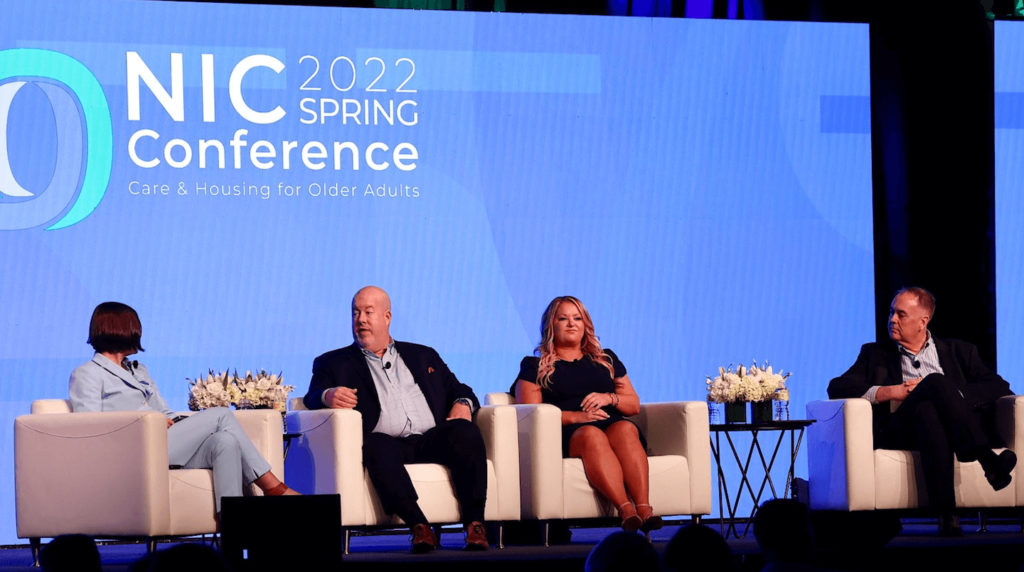

DALLAS — Senior living occupancy trends are encouraging, but it’s difficult to say with certainty when occupancy will return to pre-pandemic levels, National Investment Center for Seniors Housing & Care President and CEO Brian Jurutka said at the organization’s Spring Conference. However long it takes, the process of building back occupancy will take new approaches, according to speakers at a session during the meeting.
Since bottoming out in March 2021, the strongest growth in occupied units in seniors housing ever occurred in the third quarter of 2021, when occupancy inched up to 80.1% from a pandemic-related low of 78.7% in the second quarter. The second strongest growth that ever happened in the fourth quarter, when occupancy rose to 81%, he said at a media briefing.
“Now, the pace of recovery continues,” Jurutka said, noting, however, that senior living occupancy remains approximately six percentage points below its level two years ago, just before the pandemic hit.
When might occupancy return to its pre-pandemic level? “NIC doesn’t forecast, but what we can do is … provide context to what’s happening” using data, he said.
For majority independent living and majority assisted living properties, Jurutka said, “if you assume the pace of absorption we saw since occupancy has bottomed out and started to recover … it would take about 3.4 years for independent living and 2.3 years for assisted living to return to that pre-pandemic occupancy.”
Looking at the average pace of units filling up, however, Jurutka said, “instead of that 3.4 years for independent living, you’re looking at 8.3 years for independent living. And instead of that 2.3 years for assisted living, you’re looking at 6.8 years.”
It’s a wide range, he acknowledged, adding, “It may end up somewhere in between those two goal posts.”
Multiple constituencies
Building back occupancy in these still-challenging times, according to speakers at a session titled “A Roadmap for Building Back Occupancy,” will require a balancing act of focusing not just on prospective residents and their adult children but also on prospective workers, and of promoting safety and security efforts without dwelling on the challenges of the past two years.
Prospects want to put the pandemic behind them, but they also want to know how communities have responded to COVID-19, in case something similar happens again, said panelist Derek Dunham, vice president of client services at Pennsylvania-based marketing and branding company Varsity.
Courtney Siegel, president of California-based Oakmont Management Group, agreed.
In the past two years, she said, safety and security have become more important to residents than luxury amenities. The different emphasis, Siegel added, requires companies to change their marketing and operations accordingly.
Behind the scenes, Oakmont continuously looks at data related to things such as resident falls and use of psychotropic medications, she said, but that information is not shared with prospects, because it’s not what puts their minds at ease. Rather, she said, they are looking for people they can trust.
Toward that end, Dunham advised providers to make sure they are managing online reviews of their communities, and ask staff members to share their positive reviews online.
Of course, part of keeping residents satisfied and feeling cared for is having a fully staffed community.
Operators need to make sure their brands are designed not only to appeal to residents, prospective residents and their adult children but also to appeal to potential workers, Dunham said.
Companies need to put the same effort into marketing for recruiting purposes as they do marketing to residents to drive move-ins, Siegel added.
Oakmont recently hired a person whose full-time job is to focus on job fairs, she said. The effort has resulted in 25 to 70 job applicants per fair, a good return in the difficult California market, Siegel said. She added that the company also has partnered with area schools to try to build a pipeline of workers.
Once salespeople are hired and on the job, give them the resources they need and then hold them accountable for a certain amount of outreach, phone calls and deposits every week, Segel advised.
If it’s the property that might be hindering move-ins — say, the building is older or the units are small relative to those at other properties — Dunham suggested having units professionally staged to help prospects help prospects see the possibilities; targeting prospects at the lower end of the income range appropriate for the community; targeting single men, who may be less choosy; or using units for workforce housing or suites for visitors or residents who may choose to move in while waiting for a larger unit to become available.
Regardless, Siegel said, each community needs its own strategy for building back occupancy. Look at the inventory and compare it with the competition, she advised. And think about the value proposition, knowing that a community can’t be everything to everybody.
Read our previous coverage of the conference here or at the link below. See additional coverage in our sister publication, McKnight’s Long-Term Care News.

